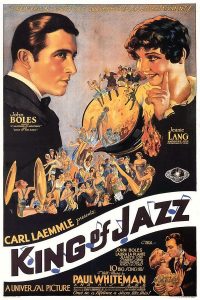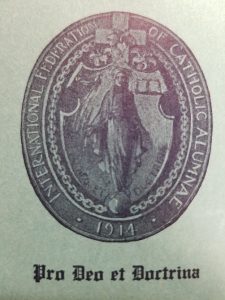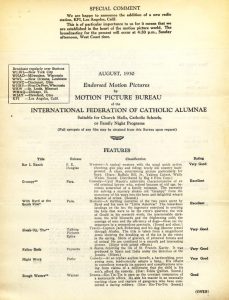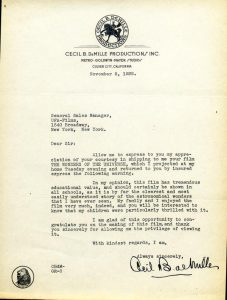
The magic of the motion picture leaves one a little breathless sometimes. And to those of us who see feature, short, travelogue, newsreel in the studio there is a tremendous sense of awe at that which motion picture accomplished for our entertainment. Of course, there are pictures we do not like…
—Rita McGoldrick, Feb. 2, 1933
Fans of our blog are probably familiar with the story of Catholic film critics through the work of the Legion of Decency/Office of Film and Broadcasting records. But that organization was not the only Catholic critic show in town in the 1930s. Alongside the Legion, there operated the Motion Picture and Broadcasting Committee of the International Federation of Catholic Alumnae (IFCA). Operating from the end of the Silent Film era through the early Talkies period, IFCA produced monthly radio and printed reports that filmgoers around the nation could tune in and subscribe to. The majority of these reports were written and performed by the Committee’s chair, Rite McGoldrick. These reports reveal the underlying moral and educational mission of IFCA, as well as the presence of cinephiles among its leadership.
Founded in November 1914, IFCA promoted the activities of Catholic teachers, religious sisters, and the alumnae networks of American Catholic colleges and universities. As part of its educational mission, IFCA focused on promoting charitable examples and combating examples of bigotry in media and in the classroom. They established eight departments, including education, literature, social service, motion pictures, bureau of sisters scholarships, religious activities committee, and the De Paul Missions Committee.

Formed in 1927, the Motion Picture Bureau (later Committee) rated films, denoting which were suitable for schools and general audiences with ratings as either ‘good,’ ‘very good,’ or ‘excellent.’ As stated in the March 1928 Quarterly Bulletin of IFCA, the guiding questions it asked of each film were: “What are suitable motion pictures for children?” and “How are we going to get the proper motion pictures to them?”
But their work goes beyond simply rating films. The Legion of Decency, another Catholic film review organization, would form later in the 1930s with the intent of reviewing and influencing the work of the film industry. In the process, the Legion would review almost any film and intervene in film production to modify films it deemed improper. The IFCA Committee, on the other hand, took a different approach. As stated in their November 29, 1929 broadcast:
To forbid people to attend the movies would be to shut out of their lives a very interesting form of entertainment which they might receive from legitimate movies. The happy plan of reviewing and classifying the movies and the talkies has been evolved by the Motion Picture Bureau of the International Federation of Catholic Alumnae. Each month this body publishes a list of plays to which Catholics may go without offending God….

Their monthly newsletter of recommended films, supplemented by a monthly radio address given during the early 1930s by Committee chair Rita McGoldrick, only discussed films that the Committee deemed appropriately moral and educational. (Unlike the Legion, they would not even think of discussing horror films!) And while their focus was on education, this did not mean that the reviewers limited their enthusiasm for newsreels or documentaries. They would express excitement over murder mysteries – The detective story lovers – and there are millions of us! – are going to have a fine time (McGoldrick, May 22, 1931). McGoldrick also would comment positively on genres ranging from jazz musicals and Rin Tin Tin movies to “Dogville Comedies” (or barkies). Educational and moral value could be seen by the reviewers to be contained in virtually any film type… so long as it wasn’t gangster movies!
But the Committee’s records do go beyond simple film reviews. Reading through them may remind a modern reader of their favorite film podcast or social media personality. In addition to discussing their recommended films, IFCA Committee members would excitedly report—in an almost casual, conversational tone—on the trends in the film industry, make predictions about how the industry may develop, share news of their favorite stars signing up for projects, and generally nerd out over the latest technological and production achievements seen on the silver screen.

Some times [sic] we wonder if you, our Radio audience, are interested in some of these technical details that go into the production of the finished picture that we accept so casually as an evening’s entertainment? To those of us who are reviewing all of the pictures and who are in intimate contact with the producing agencies, the science, vision, genius that go into productions of these greater pictures is a never-ending wonder. – Rita McGoldrick, Feb. 28, 1930
They commented on advances in sound technology and the experimentation of studios in bringing it to theaters. They also reported in 1930 on the promise of full-color features, as they broke down the technical processes behind Technicolor. And they made predictions about how sound and color—as well distribution—may impact the industry over the 1930s.
The radio broadcasts, which began in 1928 continued until at least 1933. However, the monthly newsletters denoting “endorsed motion pictures” continued until 1940. At that stage, much of the work that the Motion Picture Commission had been performing became increasingly covered by the film reviewers and censors with the Legion of Decency.
The records of the Motion Picture Committee are available in the IFCA records onsite, but have also been digitized. The files include correspondence and monthly reports from the Committee. You may see the digital collection here.
